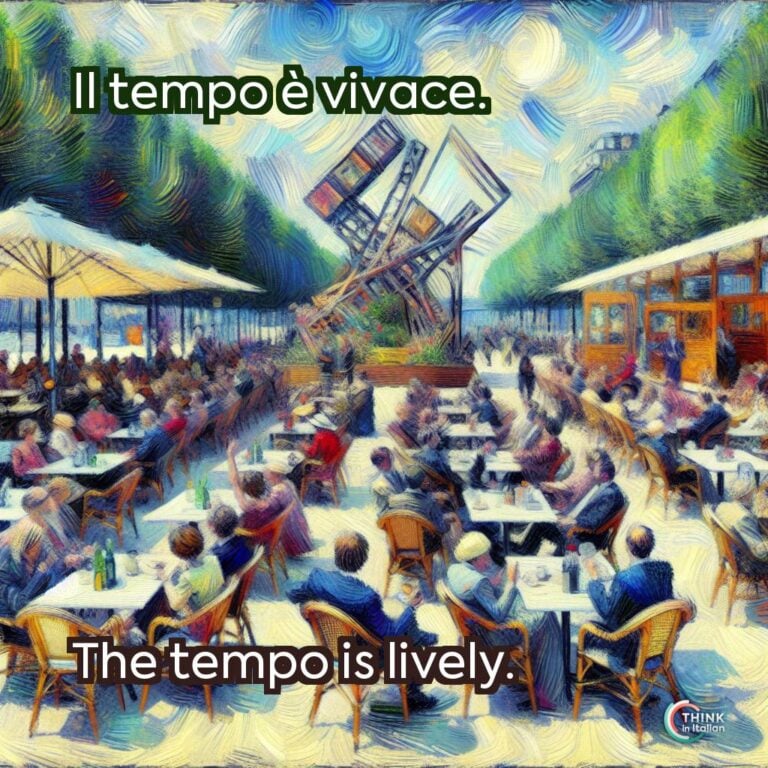Italian Music Culture
Italian music culture is rich and diverse and has a significant impact on both European and global music scenes. Here, I want to give you an overview of Italy’s rich musical panorama before we dive into a list of Italian words in music.
As you surely know already, Italy is famous for its classical music, being the birthplace of the opera in the late 16th century, which had a significant impact on French and German operatic traditions.
Besides this, each region in Italy offers its unique folk music tradition, which reflects its history, dialect, and cultural influences.
An ancient Italian folk you might know is the tarantella, originated in southern Italy in the 15th century. It is said that it was born as a remedy for tarantula spider bites: dancers whirl in a circle while holding hands and listening to upbeat music.
Chronologically speaking, after World War II, Italy embraced a variety of popular music styles. The Sanremo Music Festival, started in 1951, has been a significant influence on Italian popular music, launching the careers of many of Italy’s most famous singers.
Today, Italy’s music scene includes a mix of rock, electronic, and hip-hop, and it keeps influencing music around the world. You can see this influence in the Italian words used in the music of other cultures, as I will show below.
Did you know that music is very helpful to learn languages? Have a look at how you can learn Italian with music.
Italian Musical Terms
Italian Music Terms for Tempo
Determining the speed or tempoof a piece of music is one of the most basic and crucial components of understanding it. The beats per minute (BMP) are the most accurate way for a composer to communicate the intended speed.
However, not all musical pieces have a numerical time indication: for instance, in classical music musicians often use one or more words to describe a piece’s tempo. Not surprisingly, most of these words are Italian, as many of the most famous composers of the 17th century were Italians.
Here is a brief list of the most common Italian music terms for speed:
- Accelerando (accelerating): accelerating;
- Accompagnato (accompanied): the accompaniment must follow the singer who can speed up or slow down at will;
- Adagio (at ease): slow and easy;
- Allegro (joyful): lively and fast;
- Andante (walking): at a walking pace, moderately slow tempo;
- Grave (grave, solemn): slow and solemn tempo;
- Lento (slow): slow tempo;
- Moderato(moderate): moderate tempo;
- Rallentando(slowing down): decelerating;
- Tempo(time): the speed of music, e.g. 120 BPM;
- Tenuto(sustained): holding or sustaining a single note;
- Vivace(vivacious): fast and lively tempo (quicker than allegro).
Italian Music Terms for Dynamics
The dynamics of a piece of music refers to how quietly or loudly it should be performed. Composers use dynamics to change the mood. There are times when a piece has relatively few dynamics and other times when it has a lot of them.
The dynamics are described with Italian music terms and each one has a unique abbreviation:
- Pianissimo (very soft): pp;
- Piano(soft): p;
- Mezzo piano(moderately soft): mp;
- Mezzo forte(moderately loud): mf;
- Forte(loud): f;
- Fortissimo(very loud): ff;
- Crescendo(gradually louder): cresc;
- Diminuendo(gradually softer): dim.
Italian Music Terms for Techniques
A list of terminology related to playing techniques. The terms direct the artist to use a certain playing technique to produce the desired sound.
- Arpeggio: chord notes played in succession rather than simultaneously;
- Glissando: a continuous slide from one note to another;
- Legato: notes played with a smooth connection between them;
- Pizzicato: plucked with the finger rather than bowed;
- Portamento: a smooth slide from one note to another;
- Staccato: shortened and sharply separated notes;
- Staccatissimo: shortened and extremely separated notes;
- Vibrato: a rapid repeated slight change in the pitch of a note;
Italian Music Terms for Moods
Musical terms that indicate a playing style or mood in Italian might be used at the start of a piece of music or throughout it. A composition may have only one mood stated during its duration, or sections may have different moods that switch back and forth regularly.
These musical terms help in the formation of a mental image for the musician, as well as the development of other parts of playing such as the proper flute tone, tempo, and articulation.
The following are some frequently used Italian music terms that you may come across:
- Agitato (agitated);
- Animato(animated, lively);
- Cantabile(in a singing style);
- Dolce (sweet);
- Doloroso(sorrowful);
- Energico(energetic);
- Grazioso(graceful);
- Leggero(light, nimble);
- Maestoso(majestic);
- Risoluto(decisive, strong);
- Scherzando(playful);
- Tranquillo(calm);
Sing Your Italian
I might be biased because I love it, but music is a very important aspect of a culture. Italian musical culture is so rich that it would be a pity if you didn’t know anything about it.
Also, as a linguist, I advise you to make use of music to learn Italian. There are several good Italian songs to learn Italian. In fact, whether you are a beginner or an advanced Italian learner, music will help you improve your language skills.
Dive into the magic of Italian music, and start singing your way to fluency!








